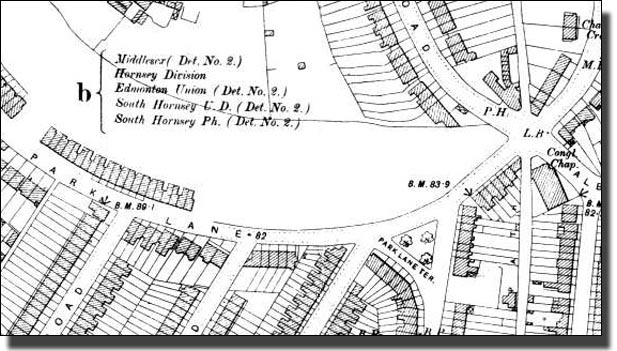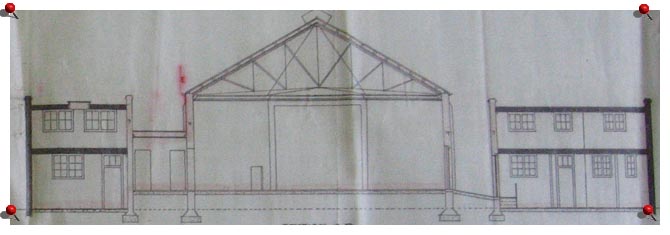|
The Albion Road houses are built in blocks of four but there was not room enough room at the and for another block. Today there is the frontage for two rather narrow houses. They look just like the others but the plan of the houses is triangular. This is almost unbelievable. What builder would spend all that money on elaborate frontages and have only have only half the floor area at the end? We shall have to wait over a century to find the reasoning behind that pair of house frontages.

Detail of the 1868 Ordnance Survey map.
Notice the garden shapes in Clissold Road
The 1868 Ordnance Survey shows that the gardens too were also extremely odd. The back garden was full length, but it ran along the old border, at a sharp angle to the road. This meant that the next few gardens were all curiously curved. They run full length but are twisted, to make up for the lack of space. It is a very odd layout indeed. The building lots had been set out according to the boundaries of the old Garden (numbered 108 on the 1868 plan). Its shape was to control the end of Clissold Road, the shops and much later the mosque, in curious ways for a century and more.
By 1894 Clissold Road had been built and so had Albion Road. The Albion Parade triangle had been set out houses on the north side of Albion Crescent but was not yet complete. The shops on the north side had not yet been started.
The building lots had been set out according to the boundaries of the old Garden. For those who would like to see what the garden was like in its prime, Click to ??++
It is numbered 108 on the 1868 plan and its shape was to control the end of Clissold Road and the shops in curious ways.

Detail of 1894 Ordnance Survey map

1914 Ordnance Survey map
The 1914 Ordnance Survey shows the completed terraces of houses in Carysfort Road and Park Lane (now Clissold Crescent). The shops along the north side of the Albion Parade frontage had been built, leaving a triangle of space behind them, hidden but valuable. In 1911 a cinema was built in this space, with its entrance through No 4 Albion Parade, a shop in the middle of the row.
 |
The Albion Road Electric Cinema in the triangular site behind the shops |

The Electric Cinema
Street plan showing the entrance through shop 4 in Albion Parade. In 2007 this is the betting shop.
Albion Road Cinema
Longitudinal Section |
 |
The shops with
flats above |
The Cinema
Notice the sloping floor.
Which end was the screen?
|
This outside of this view view can still be seen through the gap between the end of the shops and the end house of Clissold Road, which is now the mosque.

Albion Road Cinema Cross Section

Cinema Sections of many kinds

Cinema Plan showing the entrance through Shop No 4
The cinema had only 300 seats. It struggled on into the Nineteen thirties but then the huge cinema in Finsbury Park, Islington and Dalton, with their elaborate decorations, large screens and new sound systems, forced the Albion to close. It became a warehouse and later an extension to the adjoining Turkish Centre in Clissold Road. It has been refurbished, but one can still recognize its characteristic shape. Look through the gap between the Turkish Centre and the backs of the shops and the old cinema is plain to see.
Revised:
October 25, 2011 8:44 AM
| 








